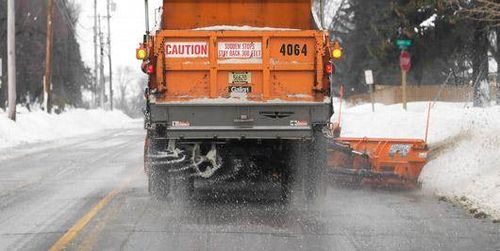
Difference between revisions of "Road salt, smart salting and winter maintenance"
m |
m |
||
| Line 1: | Line 1: | ||
| − | {{alert|This section of the manual is under construction and will be populated over the next few months. Changes and updates will be posted in the [http://stormwater.pca.state.mn.us/index.php/What%27s_New What's new] page in the manual. Information on road salt and water can be found on [https://www.pca.state.mn.us/water/road-salt-and-water-quality MPCA's website]|alert-under-construction}}. | + | {{alert|This section of the manual is under construction and will be populated over the next few months. Changes and updates will be posted in the [http://stormwater.pca.state.mn.us/index.php/What%27s_New What's new] page in the manual. Information on ''road salt and water quality'' can be found on [https://www.pca.state.mn.us/water/road-salt-and-water-quality MPCA's website]|alert-under-construction}}. |
| − | [[file:Salting truck.jpg|500px|thumb|alt=image of salting truck | + | [[file:Salting truck.jpg|500px|thumb|alt=image of salting truck]] |
MPCA recommends a low-salt diet for Minnesota waters. Doctors tell us to stick to a low-salt diet. Our lakes and streams should follow the same advice. When winter comes and snow and ice build up on Minnesota roads, parking lots, and sidewalks, one of the most common reactions is to apply salt, which contains chloride, a water pollutant. | MPCA recommends a low-salt diet for Minnesota waters. Doctors tell us to stick to a low-salt diet. Our lakes and streams should follow the same advice. When winter comes and snow and ice build up on Minnesota roads, parking lots, and sidewalks, one of the most common reactions is to apply salt, which contains chloride, a water pollutant. | ||
| Line 7: | Line 7: | ||
Salt pollutes. When snow and ice melts, the salt goes with it, washing into our lakes, streams, wetlands, and groundwater. It takes only one teaspoon of road salt to permanently pollute 5 gallons of water. Once in the water, there is no way to remove the chloride, and at high concentrations, chloride can harm fish and plant life. Less is more when it comes to applying road salt. | Salt pollutes. When snow and ice melts, the salt goes with it, washing into our lakes, streams, wetlands, and groundwater. It takes only one teaspoon of road salt to permanently pollute 5 gallons of water. Once in the water, there is no way to remove the chloride, and at high concentrations, chloride can harm fish and plant life. Less is more when it comes to applying road salt. | ||
| + | The following table of contents summarizes pages and sections in the manual that address road salt, Smart Salting (S2), and winter maintenance. | ||
*Overview and impacts of road salt and deicers | *Overview and impacts of road salt and deicers | ||
**[[How salt works]] | **[[How salt works]] | ||
| Line 33: | Line 34: | ||
**[[Smart Salting (S2) training certificate holders]] | **[[Smart Salting (S2) training certificate holders]] | ||
*[[Educational resources for Smart Salting (S2)]] | *[[Educational resources for Smart Salting (S2)]] | ||
| − | *[[Cost-benefit considerations for | + | *[[Cost-benefit considerations for Smart Salting (S2) and road salt winter maintenance]] |
| − | *[[Case studies for | + | *[[Case studies for Smart Salting (S2) and road salt winter maintenance]] |
*[[Chloride TMDL projects]] | *[[Chloride TMDL projects]] | ||
*[[Links for smart salting and road salt winter maintenance]] | *[[Links for smart salting and road salt winter maintenance]] | ||
*[[References for smart salting and road salt winter maintenance]] | *[[References for smart salting and road salt winter maintenance]] | ||
Revision as of 21:32, 28 January 2016
This section of the manual is under construction and will be populated over the next few months. Changes and updates will be posted in the What's new page in the manual. Information on road salt and water quality can be found on MPCA's website
.
MPCA recommends a low-salt diet for Minnesota waters. Doctors tell us to stick to a low-salt diet. Our lakes and streams should follow the same advice. When winter comes and snow and ice build up on Minnesota roads, parking lots, and sidewalks, one of the most common reactions is to apply salt, which contains chloride, a water pollutant.
Salt pollutes. When snow and ice melts, the salt goes with it, washing into our lakes, streams, wetlands, and groundwater. It takes only one teaspoon of road salt to permanently pollute 5 gallons of water. Once in the water, there is no way to remove the chloride, and at high concentrations, chloride can harm fish and plant life. Less is more when it comes to applying road salt.
The following table of contents summarizes pages and sections in the manual that address road salt, Smart Salting (S2), and winter maintenance.
- Overview and impacts of road salt and deicers
- Smart Salting Best Management Practices (BMPs)
- Management tools
- Smart Salting (S2) training program
- Educational resources for Smart Salting (S2)
- Cost-benefit considerations for Smart Salting (S2) and road salt winter maintenance
- Case studies for Smart Salting (S2) and road salt winter maintenance
- Chloride TMDL projects
- Links for smart salting and road salt winter maintenance
- References for smart salting and road salt winter maintenance
